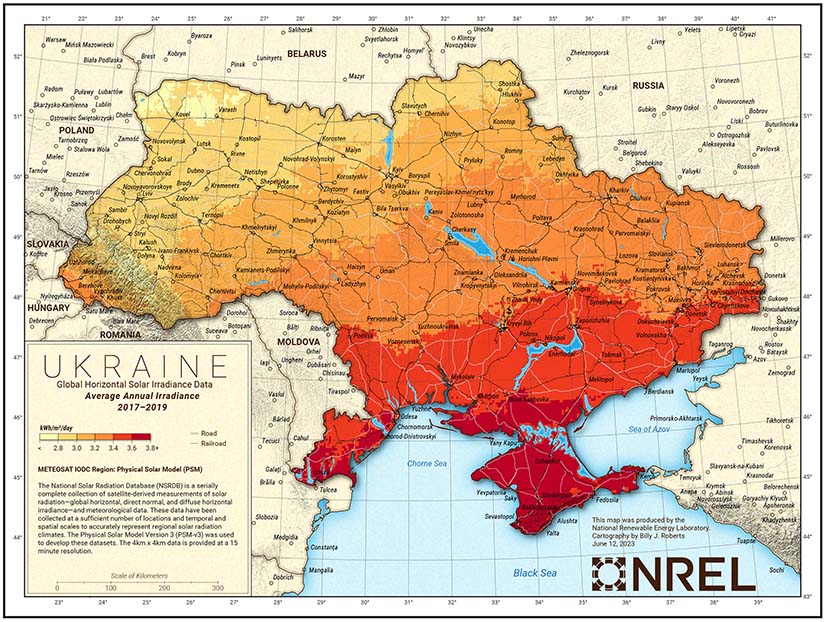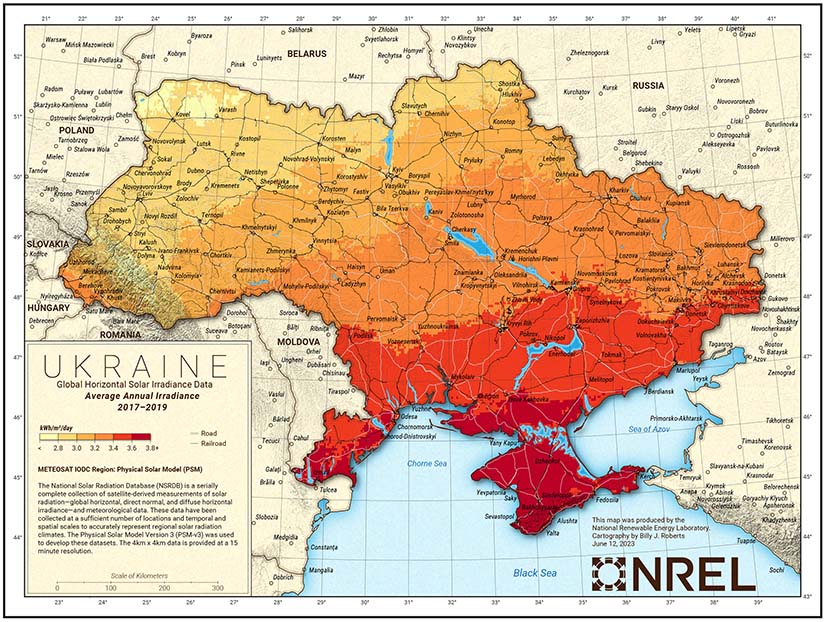
Ukraine is banking on its vast renewable energy resources to leverage itself into the European Union, but it’ll have to elbow out other nations for market space. In particular, states on the Mediterranean Sea are discovering new green gold in their wind and solar assets. Nevertheless, Ukraine policymakers are pushing ahead with plans for a green future, and their persistence could pay off in more ways than one.
Lighting A Fire Under The European Renewable Energy Revolution
Ever since Russia launched its unprovoked invasion of Ukraine on February 24, 2022, much attention has been paid to the impact of the war on the pace of renewable energy adoption in the European Union.
By underscoring the dark side of natural gas imported from Russia, the war gave a big shot of adrenaline to the offshore wind industry and other renewable energy sectors in Europe. The invasion accomplished what the initial sanctions on Russia failed to do after its annexation of Crimea in 2014.
The 2022 invasion also laid bare the geopolitical risks at work in global energy markets and centralized power generation assets, including nuclear energy.
Among other strategies targeting civilian populations in Ukraine, Russia has persistently sought to cripple the country’s ability to provide heat and power to its population, including threats to the operation of its massive Zaporazhizhia nuclear facility.
That is both a near-term war strategy and a longer-term blow against Ukraine’s efforts to integrate with the EU. As part of its case for EU membership, Ukraine has worked to portray itself as the key to cutting Europe’s dependence on Russian gas while transitioning to a low-carbon economy. That’s a tough case to make unless the country can bounce back from Russian attacks on its energy infrastructure.
To complicate matters further for Ukraine, Mediterranean nations are hungrily eyeing new markets for renewable energy in northern Europe, as recently highlighted by offshore wind activity in Spain and Portugal.
Ukraine Builds A Better Market For Renewable Energy
Ukraine had a good headstart on wind and solar adoption long before Russia annexed Crimea. CleanTechnica began covering renewable energy activity in Ukraine at least 10 years ago, when Vestas took an order for 90 wind turbines in 2012 (see lots more CleanTechnica coverage of Ukraine here).
Until recently, though, the country lacked a market plan for accelerating its renewable energy industry. One key structural obstacle has been the country’s state-owned Guaranteed Buyer intermediary organization, which locks renewable energy producers into rigid contracts.
That is changing. Earlier this year the parliament of Ukraine passed Law No. 3220-IX, aimed at stimulating the country’s renewable energy industry.
The Ukrainian energy and climate expert Maryna Denysiuk, who holds the post of Senior Project Manager at the Reforms Delivery Office in the country’s Cabinet of Ministers, explains how the new law provides for alternatives to the Guaranteed Buyer system.
“The law allows the producer to leave the balancing group of the GB [Guaranteed Buyer] and choose an alternative way to sell its electricity on the market, increasing competition, instead of guaranteeing the purchase of the entire volume of electricity at a fixed price,” Denysiuk wrote in an article posted at Ukrinform.net on November 26.
“In the face of constant shelling, the resilience of the power system can be strengthened by the availability of backup, autonomous and decentralized energy supply, including from renewable sources. That is, we need energy from the sun, wind, water, biomass, and biogas,” she added.
Decentralizing For Resilience & Revival
Among many other provisions of Law No. 3220-IX, Denysiuk highlighted the creation of a system for guaranteeing the origin of Ukraine-produced electricity for export, with an eye on satisfying renewable energy buyers in Europe. The mechanism is expected to be up and running in Ukraine by September of 2024, with regional coordination to follow as an essential element in Ukraine’s EU integration.
Denysiuk also emphasized that Law No. 3220-IX is just the beginning. Additional supporting legislation and other parliamentary actions are also needed. In particular, she made the case for prioritizing the decentralization of energy assets. That includes repurposing old power generation sites.
The long-defunct Chornobyl nuclear power site near Kyiv has already become a renewable energy repurposing showcase. Somewhat ironically, the history-making disaster that shut the plant down in 1986 is credited with fostering the breakup of the Soviet Union and the independence of Ukraine.
In 2018, the Ukrainian company Rodina and Germany’s Enerparc AG constructed a 1-megawatt solar power plant at the site, aimed at demonstrating the feasibility of constructing renewable energy facilities at the scene of a nuclear disaster. Apparently, someone got the message, because plans are now in the works to construct a 1-gigawatt wind farm there.
Russia’s practice of bombing civilian targets has created many more opportunities to repurpose old power generation sites in Ukraine.
“It should be recalled that about 50% of generating capacities have been damaged, some of which cannot be restored,” Denysiuk explains. “That is why the construction of shunting capacities will be of the utmost importance (namely, energy storage facilities, hydroelectric power plants, bioTPPs, bioCHPPs, as well as pumped-storage hydroelectricity and highly efficient modern peaking power plants).”
And Green Hydrogen, Of Course
Reading between the lines, “modern peaking power plants” may include natural gas with carbon capture. However, that remains to be seen. In addition to biomass resources for power generation, Ukraine has already begun laying plans to position itself as a green hydrogen asset for the EU. Meanwhile, Mitsubishi and other engineering firms have begun introducing gas turbines designed to run on green hydrogen.
The Ukrainian organization Razom has also been advocating for the creation of a green hydrogen industry in Ukraine, as part of its support for the country’s renewable energy transition.
Reporting on a collaborative renewable energy initiative between Ukraine and Germany on October 25, Razom communications specialist Maksym Gardus noted that the participants agreed on the “importance of rapidly introducing decentralized alternative energy sources to ensure the reliable and stable operation of the energy system.”
“Participants noted that the war cannot become an obstacle to the energy transition, but rather should serve as an incentive to actively accelerate it,” Gardus added.
Gardus also drew attention to a Memorandum of Understanding between Ukraine and the EU. Covering a partnership on hydrogen and synthetic gasses, the new MOU builds on previous green hydrogen agreements. “Sustainable electricity and green hydrogen are considered to be the driving forces behind the energy transition,” Gardus emphasized.
Signs of increased cooperation between Germany and Italy could help motivate the Ukrainian parliament to prioritize renewable energy legislation in the coming months. On November 22, Reuters reported that “a pipeline to transport gas and hydrogen” between Germany and Italy was among several key issues on the table.
Plans for a green hydrogen network have been cropping up in Germany, but the country is also on the prowl for additional resources. That could include a connection to Italy’s newly minted green hydrogen assets in the Middle East.
If Ukraine keeps building on its plans for renewable energy and green hydrogen, the result will be twofold: A more resilient domestic economy for Ukraine and a real-time demonstration of the power of sustainable policymaking to take down an authoritarian regime propped up by anachronistic principles of energy production.
Follow me @tinamcasey on Bluesky, Threads, Post, and LinkedIn.
Image: Solar resource data map of Ukraine courtesy of US National Renewable Energy Laboratory.
- SEO Powered Content & PR Distribution. Get Amplified Today.
- PlatoData.Network Vertical Generative Ai. Empower Yourself. Access Here.
- PlatoAiStream. Web3 Intelligence. Knowledge Amplified. Access Here.
- PlatoESG. Carbon, CleanTech, Energy, Environment, Solar, Waste Management. Access Here.
- PlatoHealth. Biotech and Clinical Trials Intelligence. Access Here.
- Source: https://cleantechnica.com/2023/11/27/renewable-energy-race-pits-ukraine-against-mediterranean-states-for-eu-market/
- :has
- :is
- $UP
- 10
- 2012
- 2014
- 2018
- 2022
- 2024
- 22
- 24
- 25
- 26
- a
- ability
- About
- accelerate
- accelerating
- accomplished
- actions
- actively
- activity
- added
- addition
- Additional
- Adoption
- adrenaline
- advocating
- After
- AG
- against
- ago
- ahead
- aimed
- allows
- already
- also
- alternative
- alternatives
- among
- an
- and
- ARE
- article
- AS
- Assets
- At
- Attacks
- attention
- Authoritarian
- autonomous
- availability
- back
- Backup
- balancing
- Banking
- BE
- because
- become
- been
- before
- Beginning
- begun
- behind
- Better
- between
- Big
- biogas
- biomass
- blow
- bluesky
- both
- Bounce
- Building
- builds
- but
- BUYER..
- buyers
- by
- cabinet
- CAN
- cannot
- capacities
- capture
- carbon
- carbon capture
- case
- centralized
- changing
- Choose
- Climate
- collaborative
- coming
- Communications
- company
- competition
- connection
- considered
- constant
- construct
- constructing
- construction
- contracts
- cooperation
- coordination
- could
- country
- country’s
- coverage
- covering
- created
- creation
- cutting
- Dark
- data
- Decentralization
- decentralized
- delivery
- demonstrating
- dependence
- designed
- disaster
- discovering
- do
- Domestic
- down
- driving
- Earlier
- economy
- efficient
- efforts
- electricity
- element
- emphasized
- energy
- Engineering
- ensure
- Entire
- essential
- Ether (ETH)
- EU
- Europe
- European
- european union
- Europes
- expected
- Explains
- export
- eye
- Face
- facilities
- Failed
- feasibility
- February
- Fire
- firms
- fixed
- follow
- For
- Forces
- fostering
- from
- further
- future
- GAS
- gave
- generating
- generation
- Germany
- Global
- Gold
- good
- got
- Green
- Group
- guaranteed
- had
- Have
- headstart
- help
- Highlighted
- highly
- holds
- How
- However
- HTML
- HTTPS
- Hydroelectricity
- hydrogen
- Impact
- importance
- in
- Incentive
- include
- includes
- Including
- increased
- increasing
- independence
- industry
- Infrastructure
- initial
- Initiative
- instead
- integrate
- integration
- intermediary
- into
- introducing
- invasion
- Ironically
- issues
- IT
- Italy
- ITS
- itself
- jpg
- just
- Key
- laboratory
- launched
- Law
- laying
- least
- Leave
- Legislation
- Leverage
- lines
- Locks
- Long
- lots
- low-carbon
- made
- make
- manager
- many
- Market
- Markets
- massive
- Matters
- May..
- me
- Meanwhile
- mechanism
- Mediterranean
- membership
- Memorandum
- memorandum of understanding
- message
- Middle
- ministers
- minted
- Modern
- months
- more
- MOU
- much
- namely
- National
- Nations
- Natural
- Natural Gas
- Near
- Need
- needed
- Nevertheless
- New
- newly
- no
- noted
- November
- now
- nuclear
- Nuclear Energy
- Nuclear power
- obstacle
- october
- of
- off
- Office
- Old
- on
- ONE
- operation
- opportunities
- order
- organization
- Origin
- Other
- out
- Pace
- paid
- parliament
- Parliamentary
- part
- participants
- particular
- Partnership
- passed
- Pay
- persistence
- persistently
- pipeline
- plan
- plans
- plant
- plants
- plato
- Plato Data Intelligence
- PlatoData
- policymakers
- policymaking
- population
- populations
- Portugal
- position
- Post
- posted
- power
- power plants
- practice
- previous
- price
- principles
- Prioritize
- prioritizing
- producer
- Producers
- Production
- project
- provide
- provides
- purchase
- Pushing
- Race
- rapidly
- rather
- real-time
- recently
- regime
- regional
- reliable
- remains
- Renewable
- renewable energy
- Reported
- resilience
- resilient
- resource
- Resources
- restored
- result
- Reuters
- rigid
- running
- Russia
- russian
- Russian gas
- Sanctions
- scene
- SEA
- Sectors
- see
- seen
- sell
- senior
- September
- serve
- several
- she
- shot
- should
- showcase
- shut
- side
- since
- site
- Sites
- solar
- Solar Power
- some
- Someone
- somewhat
- sought
- Sources
- soviet
- Space
- Spain
- specialist
- stable
- state-owned
- States
- storage
- strategies
- Strategy
- strengthened
- structural
- Sun
- supply
- support
- Supporting
- sustainable
- synthetic
- system
- table
- Take
- targeting
- targets
- than
- that
- The
- their
- There.
- this
- this year
- though?
- threats
- to
- took
- tough
- transition
- transport
- Ukraine
- Ukraines
- Ukrainian
- under
- understanding
- union
- unprovoked
- us
- utmost
- Vast
- volume
- war
- was
- Water
- Way..
- ways
- we
- WELL
- What
- when
- which
- while
- WHO
- why
- will
- wind
- with
- Work
- worked
- works
- wrote
- year
- years
- zephyrnet








